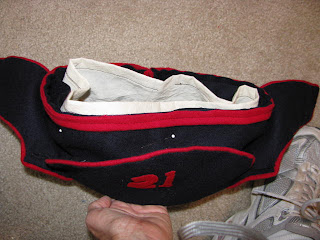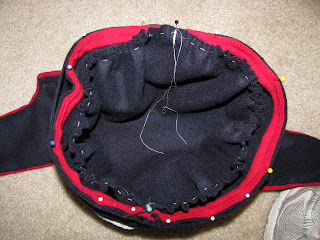Greetings! Let's finish that pokalem!
Sew red trim to the upper edge of outer band
section. (This can be done on machine
using ¼ inch seam). Sew outer section of
the band into a cylinder. Sew the other section of the band into a
cylinder. Second cylinder does not have
trim.
Edge stitch the long side of both drawstring liner
pieces. Sew into a cylinder, turn under
5/8 inch on one side of the drawstring liner piece. Stitch 1/2 inch away from the edge forming a hem. Leave a one inch for an opening for the cord
to go through
Take the band cylinder (the one without the trim) and attach the drawstring liner at the dotted
line. You are applying the right side of the drawstringliner to the right side of the cylinder. The top of
the liner will face down and to topside of cylinder
will be up.
Stitch ¼ inch seam as shown on
pattern
piece for drawstring liner. Flip liner over to cover seam and press.
Sew the bands, the
escutcheon, and earflaps together as follows. Make sure that the buttonhole
for the chinstrap is on the left side when the item
is finished.
Take cylinder with the red trim (trim is at the
top). Pin the bottom center front of cylinder with
escutcheon
center front.
Pin center back of the earflap piece to the center back of the cylinder (the seam is the center
back). Pin all the way around, earflap front edge will go over
the escutcheon edge on both sides.
Here is the drawing and a photo. Pay attention to the dotted lines, that the eschtcheon is under the earflaps.
Now it is really starting to look like something!
Take the cylinder with the liner attached, turn it
wrong side out, fit it over the pieces just pinned. Be sure that liner is not going to be caught
in bottom seam, and that the top of the cylinder with the liner is at the top. Match center back seams, pin. Sew a ¼ inch seam at the bottom.
Press open the seam, turn band with liner so
that it is inside the hat, press. Run
drawstring through hem of liner. Pin the
top edge of the band pieces together.
Leave pokalem inside out. Place a
pin at center back and center front.
Hand gather the top. (I do it in 2 sections because it is easier
to control).
Place a pin at center
front and center back of top circle piece. Do you see the green pin heads?
Pin top to band at center front and center back. Gather top to fit the band and pin all the
way around. Leave an opening on each
side for the earflap to tuck inside the hat.
Sew the top and band together by hand with a ¼ inch seam.
Turn right side out.
Tuck earflaps through openings so you can
mark where your buttons need to be on the escutcheon.
Sew on buttons to escutcheon only; do not sew
through into the band. Tie drawstring
and try on hat for fit, adjust drawstring if necessary. Un-tuck earflaps to mark for button on chin
strap. Sew on chin button.
You are done! Here is the completed pokalem!
Thanks for modeling Jason!























